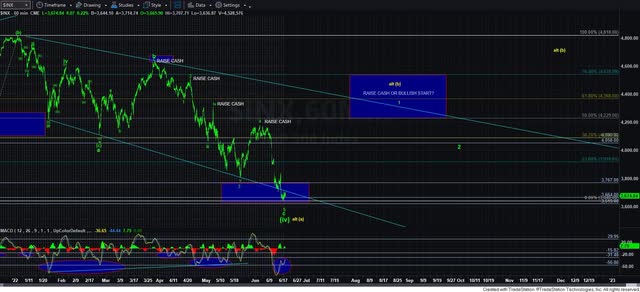Florent Molinier
The more I read public articles and the comments thereto, the more hair I tear out of my hair. (Yea, I know, I don’t have much left).
As I read about how this person is looking towards the FOMC to know what is going to happen with the market, and how that person is looking at economic reports to know what is going to happen with the market, and then a third person is tracking inflation to know what will happen to the market… it just makes your head spin.
Yet, has anyone realized that nothing has really changed since the market was tanking into the June low? Amazingly, we still seem to have rallied 700 points off that low. And, yes, this rally has been within the expectations I outlined to our members of The Market Pinball Wizard at the June low:
And, again, nothing has really changed in the market environment. We still have high inflation. The Fed is still raising rates. And, the economic reports may even be getting worse. But, we still rallied 700 points off the low.
Almost every single investor has a “story” that they are investing based upon. And, these investors endlessly debate their stories and perspectives in the comments sections of articles such as this. In fact, I have seen bearish analysts (who weave their bearish stories to those willing to listen) that have been calling the market names because this rally did not fit their “story.” But, how many investors truly challenge themselves when it comes to their underlying premise? Have you ever challenged your own perspective?
Before you answer that question, I am going to turn your perspective on its head with a little psychology, as presented by various experts in market psychology.
Let’s start with Robert Prechter, who stated the following in his seminal book The Socionomic Theory of Finance:
“Observers’ job, as they see it, is simply to identify which external events caused whatever price changes occur. When news seems to coincide sensibly with market movement, they presume a causal relationship. When news doesn’t fit, they attempt to devise a cause-and-effect structure to make it fit. When they cannot even devise a plausible way to twist the news into justifying market action, they chalk up the market moves to “psychology,” which means that, despite a plethora of news and numerous inventive ways to interpret it, their imaginations aren’t prodigious enough to concoct a credible causal story.
Most of the time it is easy for observers to believe in news causality. Financial markets fluctuate constantly, and news comes out constantly, and sometimes the two elements coincide well enough to reinforce commentators’ mental bias towards mechanical cause and effect. When news and the market fail to coincide, they shrug and disregard the inconsistency. Those operating under the mechanics paradigm in finance never seem to see or care that these glaring anomalies exist.”
I think Mr. Prechter hit the nail on the head as to how investors process information. But, many others have made similar observations.
In The Behavioral Investor, Daniel Crosby similarly noted the following:
“Storytelling bypasses many of the critical filters we apply to other forms of information gathering . . . For this reason, stories are the enemy of the behavioral investor. . . . Nowhere is the power of a narrative more fully realized than in IPO investing. . . . Cogliati, Paleari and Vismara who in ‘IPO Pricing: Growth Rates Implied in Offer Pricing’ that the average IPO in the US has gone on to underperform the market benchmark by 21% per year in the first three years following its release. Despite massive underperformance, there is no good reason to suppose that demand for IPOs will wane in popularity in the years to come. After all, there will always be stories.”
As a side, Zac Mannes (lead analyst of the StockWaves service on Seeking Alpha) and I performed a study on IPOs, which supports the conclusions noted above from a market sentiment perspective: Why You Should Not Buy IPOs.
But, I digress.
Moving on, I want to present one final perspective from Thinking Fast and Slow, which was written by Daniel Kahneman, who won a Nobel Memorial Prize in Economic Sciences for his findings which challenged the assumption of human rationality prevailing in modern economic theory. “Evidence is that we are born prepared to make intentional attributions.” In other words, our minds engage in an automatic search for causality. Moreover, Kahneman noted that we also engage in a deliberate search for confirming evidence of those propositions once we hold them dear. This is known as “positive test strategy.”
“Contrary to the rules of philosophers of science, who advise testing hypotheses by trying to refute them, people seek data that are likely to be compatible with the beliefs they currently hold. The confirmatory bias [of our minds] favors uncritical acceptance of suggestions and exaggerations of the likelihood of extreme and improbable events . . . [our minds are] not prone to doubt. It suppresses ambiguity and spontaneously constructs stories that are as coherent as possible.”
As more and more groundbreaking work is being conducted into the psychological aspects of the stock market, investors are beginning to rise above “storytelling,” to a more sophisticated and accurate perspective of how markets work. In a paper entitled “Large Financial Crashes,” published in 1997 in Physica A, a publication of the European Physical Society, the authors, within their conclusions, present a nice summation for the overall herding phenomena within financial markets:
“Stock markets are fascinating structures with analogies to what is arguably the most complex dynamical system found in natural sciences, i.e., the human mind. Instead of the usual interpretation of the Efficient Market Hypothesis in which traders extract and incorporate consciously (by their action) all information contained in market prices, we propose that the market as a whole can exhibit an “emergent” behavior not shared by any of its constituents. In other words, we have in mind the process of the emergence of intelligent behavior at a macroscopic scale that individuals at the microscopic scales have no idea of. This process has been discussed in biology for instance in the animal populations such as ant colonies or in connection with the emergence of consciousness.”
So, are you ready to turn off the TV and begin to actually listen to the market rather than the pundits who simply regurgitate the “common-think?”
“Trusting in common myths is what makes you human. But learning not to is what will make you a successful investor.” – Daniel Crosby
In fact, I am constantly thanked by my members for urging them to turn off the pundits and focus on price:
“I’m a relatively novice trader and a member of Avi’s service for nearly two years now . . . I used to spend hours and hours pouring over SA articles trying to decipher the never ending blathering of why stock A was going to up, only to find in the comments, 1000 reason why stock A was going down – an utter waste of time. Avi’s analysis is ZERO bias..no book to talk, no bs, no spin, no ego…no manipulation or clickbait articles. Just incredibly accurate analysis to trade. So, unless you like debating endlessly with 00s of strangers why ATT is the best investment ever or the worst investment ever…. dozens of times per month…I suggest you UNLEARN what you think you know. I would like to say THANK YOU to Avi. The learning I have gain and shift in perspective is truly incredible!”
So, in moving on to our perspective on the market, it is rather simple right now. Upper support in the market is 3950-4090SPX. And, as long as we hold that support, I am next targeting the 4400SPX region. Thereafter, I am expecting us to revisit the 4000SPX region. And, clearly, a sustained break-down below 3950-4090SPX would potentially invalidate this potential, and place us in a potentially bearish posture again.
Housekeeping Matters
If you would like notifications as to when my new articles are published, please hit the button at the bottom of the page to “Follow” me.



Be the first to comment